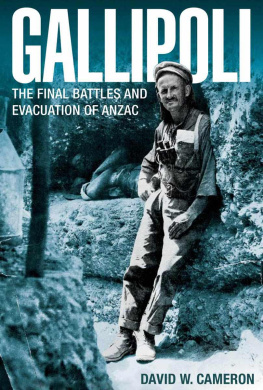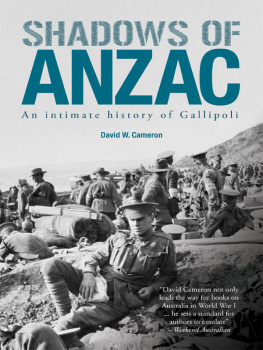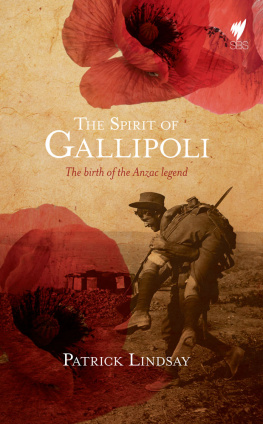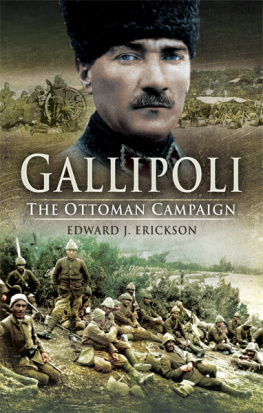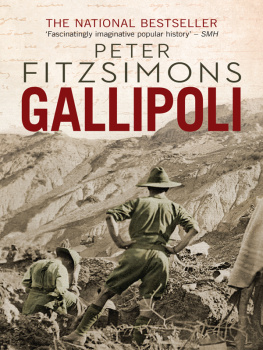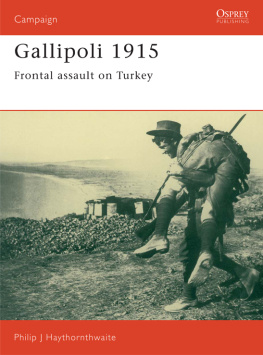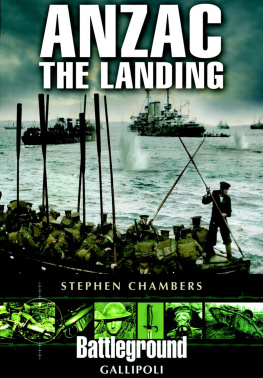
THE FINAL BATTLES AND EVACUATION OF ANZAC

THE FINAL BATTLES AND EVACUATION OF ANZAC

www.bigskypublishing.com.au
DAVID W. CAMERON PH.D.
Copyright David W. Cameron Ph.D. 2011
First published 2011
Copyright remains the property of the author and apart from any fair dealing for the purposes of private study, research, criticism or review, as permitted under the Copyright Act, no part may be reproduced by any process without written permission.
All inquiries should be made to the publishers.
Big Sky Publishing Pty Ltd
PO Box 303, Newport, NSW 2106, Australia
Phone: | (61 2) 9918 2168 |
Fax: | (61 2) 9918 2396 |
Email: | info@bigskypublishing.com.au |
Web: | www.bigskypublishing.com.au |
Cover design and typesetting: Think Productions
National Library of Australia Cataloguing-in-Publication entry
Author: Cameron, David Wayne, 1961-
Title: Gallipoli: the final battles and evacuation of Anzac / David W. Cameron.
ISBN: 9780980814095 (pbk.)
Notes: Includes bibliographical references and index.
Subjects: Australia. Army. Australian and New Zealand Army
CorpsHistory.
World War, 1914-1918CampaignsTurkeyGallipoli Peninsula.
Gallipoli Peninsula (Turkey)History, Military20th century.
Dewey Number: 940.426
CONTENTS
This book is dedicated to mu beautiful wife Deborah and our wonderful children, Emma, Anita and Lloyd

Main topographical features at Anzac, Old Anzac area marked for more details see facing page.

Main topographical features at Old Anzac
Q = Quinns Post; C = Courtneys Post; S = Steeles Post; T.Q. = Turkish Quinns; G.O.T. = German Officers Trench; W.F. = The Wheatfield; L.T. = Leanes Trench (Turkish Despair Works).
INTRODUCTION
Despite the failure of the August Offensive at Gallipoli the senior commanders still believed victory was possible. To help prepare for a new offensive sometime in the first half of 1916 the Allied forces attempted to straighten out the line between the Suvla Bay and Anzac sectors at a small hillock called Hill 60. This tactically meaningless piece of Gallipoli real estate would cost the lives of thousands of men from both sides. Many, with justification, would argue that the fighting at Hill 60 was even worse than the fighting at Lone Pine a few weeks earlier. The end result was a huge casualty list for gaining just a few hundred metres of ground. This was soon followed by one of the coldest winters on record for the peninsula, resulting in some trenches being flooded, with hundreds of troops, most still uniformed in shorts and sleeveless shirts, suffering from the intense cold. Piers and wharves were continually wrecked and supplies dangerously low. With this, the Gallipoli Campaign ground to a halt.
Now, the machinations of politicians in London, egged on by some senior military commanders who wanted the Gallipoli fiasco over with, came to the fore. Anyone with any common sense knew they would argue that the war had to be fought on the Western Front. Men and material, they said, should not be wasted on sideshows like Gallipoli. Meanwhile, journalists such as Ellis Ashmead-Bartlett and Keith Murdoch also argued for the campaign to be ended, but for very different reasons. Ashmead-Bartlett had seen first-hand the blundering ad hoc battles that were fought with seemingly little tactical or strategic appreciation of the conditions. The August Offensive was yet another demonstration, if that was needed, that the senior commanders were well and truly out of their depth, throwing away the lives of their men against Turkish strongholds in hopeless situations with no prospect of success. Now, everywhere just beyond the Anzac and Turkish lines, at places like Lone Pine, bodies, exposed in the summer heat (Oh the stench), actually helped define the trench parapets. Ashmead-Bartlett was keen to tell everyone and anyone prepared to listen that the peninsula had to be evacuated before winter set in Murdoch arrived for a few days and listened. Murdoch was aware that since he had only been on the peninsula for a few days, his views would carry little weight. Both agreed that Ashmead-Bartlett would write to the British Prime Minister bypassing the military censor and that Murdoch would deliver it personally and endorse wholeheartedly its contents. All would not go exactly as planned, but the resulting furore would dramatically impact on the campaign over the coming months.
Even up until early December 1915, the politicians and senior military commanders in London debated the pros and cons of abandoning the peninsula. Should they expand their operations in Salonika (Greece) with troops from Gallipoli, should they close down the Salonika operation and reinforce Gallipoli or should they close down both Salonika and Gallipoli? It was a close run thing. But in the end they reached the only sensible position that was possible to evacuate the Gallipoli Peninsula. So began the only really successful part of the whole Gallipoli stunt the evacuation.

In helping to write this history, I would like to first thank John Shephard, Peter Hart and Rhys Crawley. Each has read numerous chapters and critiqued the manuscript. It should go without saying any remaining errors in this history are mine alone. Thanks John, Peter and Rhys.
It would also be impossible to approach any history of Gallipoli Anzac without having relied on the works of a few key researchers/historians. I and many others owe a debt to Charles Bean (Australian Official History series), C.F. Aspinall-Oglander (British Official History series), and Christopher Pugsley (Gallipoli the New Zealand Story) .
A big thank you must go to those men who published their battalion histories in the 1920s and 30s as well as those who put pen to paper in such journals as Reveille . Journals like Reveille and Stand-to contain real historical gold dust all too often overlooked and ignored. It must be remembered that the writers in such journals were in many cases writing to their peers, which is a great editorial mechanism - filter. They provide a wealth of material, some humorous, some very tragic.
Like all researchers I am indebted to those soldiers who not only kept a record of their experiences but also unselfishly donated their precious documents, writings and curios to numerous research institutions for others to study. This also applies to relatives who have provided similar valuable records. For those copyright holders I was unable to locate I trust that the material quoted meets with your approval.
I am especially indebted to Dr Margaret Heese, the daughter of then Lance-Corporal Cyril Lawrence, for allowing me to quote from her fathers diary. His diary (held at the Australian War Memorial) and published by Melbourne University Press in the early 1980s, is a detailed account of one mans experience during the Gallipoli Campaign.
Next page
